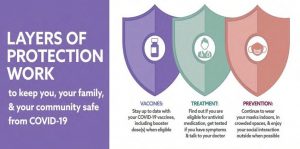Toronto Medical Officer of Health Dr. Eileen de Villa urges use of ‘layers of protection’ vs dangerous viruses
Toronto Medical Officer of Health Dr. Eileen de Villa urges use of ‘layers of protection’ vs dangerous viruses

DR. EILEEN DE VILLA
By Mila Astorga-Garcia
The Philippine Reporter
TORONTO — Dr. Eileen de Villa, Medical Officer of Health of the City of Toronto, urged once more the need for people to use the various ”layers of protection” to prevent illnesses caused by different viruses that continue to threaten the health of Torontonians and the overall population.
“The more we use the various layers of protection, the protected we are from diseases,… and the more we are sure that we can deliver the necessary services” to keep Toronto healthy, De Villa said.
De Villa was speaking before the officers and members of the National Ethnic Press and Media Council of Canada (NEPMCC) during its regular Zoom meeting on Monday, Nov. 14, 2022.
Layers of protection
“Layers of protection” are actually the different measures one can use to prevent the spread of COVID and other diseases, to protect individuals, families and community.
The call to remember and observe these measures is usually done when an increase in COVID cases is expected and actually experienced, as people gather with family and friends for this holiday season.
These measures that form part of the “layers of protection,” have traditionally been the following, according to De Villa:
 * Stay home if you are unwell.
* Stay home if you are unwell.
• Get all of your recommended COVID-19 vaccination doses, including any booster dose(s).
• Reduce or limit your close contacts.
• Keep a physical distance when possible, especially indoors.
• Wear a high quality, well-fitting mask, especially indoors.
• Wash or sanitize your hands often.
• Choose well ventilated spaces when possible
During the presentation De Villa presented them in a consolidated manner through an updated TPH visual that organizes these layers into three categories colourfully illustrated as three “shields” to keep individuals, families and communities safe from COVID-19: vaccines, treatment and prevention. (See Visual 5 titled ‘Layers of Protection Work.’)
“Using all these measures together is critical in prevention,” De Villa emphasized.
Role of Toronto Public Health
De Villa explained the role of Toronto Public Health (TPH) which is responsible for the health and wellbeing of Toronto’s almost three million residents, and whose work is focused on protecting and promoting the health, as enshrined in its mandate since 1883. (Visuals 1, 2, and 3)
TPH does this by:
• preventing the spread of disease, promoting healthy living and advocating for conditions that improve health for Toronto residents
• using surveillance to monitor the health status of the population in order to respond to on-going and emerging health needs
• developing and implementing public policy and practices that enhance the health of individuals, communities and the entire city
Determinants of health
What fundamentally drive the experience of public health work are the determinants of health, De Villa emphasized. She said health is very much a social and economic issue, and much more than just individual genetics and lifestyle choices.
These determinants, as defined by Health Canada, are a broad range of social, economic and environmental factors that determine individual and population health. These include:
• Income and social status
• Employment and working condition
• Education and literacy
• Childhood experiences
• Physical environments
• Social supports and coping skills
• Healthy behaviours
• Access to health services
• Biology and genetic endowment
• Gender
• Culture
• Race / Racism
During the question and answer period, a NEPMCC member pointed out that housing was an important factor in determining one’s health.
De Villa agreed and said that homelessness impacts on the health of individuals and housing with all the supports needed by individuals and community is essential.
Partnerships
Lastly, De Villa emphasized how important partnerships are in making the work of public health possible. She elaborated that she meant partnership with other government agencies, non-government agencies, businesses, professional associations, universities and other institutions, health delivery services, communities and media to enable TPH to deliver its mandate efficiently and effectively.
She said that partnership with ethnic media has been essential in reaching out to the diverse population of Toronto regarding critical health matters that would benefit the wellbeing of individuals and communities, especially during a health crisis.
On that note, she thanked the NEPMCC for the opportunity to speak before its members, for supporting public health efforts by informing Toronto’s diverse communities about critical health information, and for maintaining the kind of partnership that has existed through the years.
Comments (0)